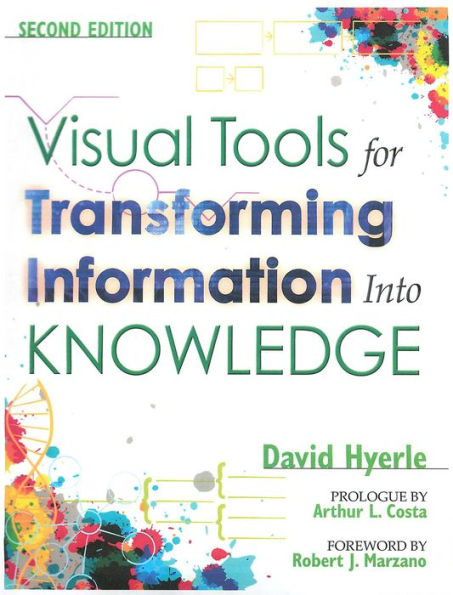Visual Tools for Transforming Information into Knowledge (2nd edition)
This text is actually the third edition of the visual tools series starting with the groundbreaking book distributed to over 150,000 educators in 1996 (Visual Tools for Constructing Knowledge: Hyerle, D.: ASCD). There is no other book that shows the comprehensive array of examples and step by step uses of visual tools while also considering the implications for these tools for 21st century learning and improving thinking. This new edition is a practical view of how the full range of visual tools and technologies are used in education and for lifelong learning. Visual Tools are nonlinguistic symbol systems used in very practical ways by learners, teachers, and leaders for graphically linking mental and emotional associations to create and communicate rich patterns of thinking. These visual-spatial-verbal dynamic designs support all learners in transforming static information into active knowledge, thus offering a complementary representational system to more traditional literacies grounded in speaking, writing, and numerating. These linear a n d / o r nonlinear visual forms are also metacognitive tools for self-assessment in each content area and for interdisciplinary learning that unite linguistic, numerical, and scientific languages together on the same page. As fully investigated in this book-- with practical step-by-step processes for use and examples-- there are three basic categories of visual tools, each with specific purposes and visual configurations:brainstorming webs for fostering creativity and open mindedness;graphic organizers for fostering analytical content and process specific learning; conceptual mapping for fostering cognitive development and critical thinking.A fourth category is the only synthesis language of visual tools and has been used extensively across schools. Thinking Maps®, developed by David Hyerle, Ed.d., is introduced in two chapters as a common visual language of visual tools for mainstream and special needs students, integrating the creative dynamism of webs, the analytical structures of content-specific learning, and the continuous cognitive development and reflections fostered through conceptual mapping. Over time, new visual languages may develop that integrate different visual tools and thus enable a greater range of thinking, communication, and reflection. Visual tools are used for personal, collaborative, and social media communication, negotiation of meaning, and networking of ideas. These graphics are constructed by individuals and/or collaborative learners across media networks and different technologies. Because of the visual accessibility and natural processes of "drawing out" ideas, many of these dynamic and expandable graphics are used from early childhood through adulthood, and across dimensions of learning, teaching, assessing, and leadership processes.
"1117105620"
Visual Tools for Transforming Information into Knowledge (2nd edition)
This text is actually the third edition of the visual tools series starting with the groundbreaking book distributed to over 150,000 educators in 1996 (Visual Tools for Constructing Knowledge: Hyerle, D.: ASCD). There is no other book that shows the comprehensive array of examples and step by step uses of visual tools while also considering the implications for these tools for 21st century learning and improving thinking. This new edition is a practical view of how the full range of visual tools and technologies are used in education and for lifelong learning. Visual Tools are nonlinguistic symbol systems used in very practical ways by learners, teachers, and leaders for graphically linking mental and emotional associations to create and communicate rich patterns of thinking. These visual-spatial-verbal dynamic designs support all learners in transforming static information into active knowledge, thus offering a complementary representational system to more traditional literacies grounded in speaking, writing, and numerating. These linear a n d / o r nonlinear visual forms are also metacognitive tools for self-assessment in each content area and for interdisciplinary learning that unite linguistic, numerical, and scientific languages together on the same page. As fully investigated in this book-- with practical step-by-step processes for use and examples-- there are three basic categories of visual tools, each with specific purposes and visual configurations:brainstorming webs for fostering creativity and open mindedness;graphic organizers for fostering analytical content and process specific learning; conceptual mapping for fostering cognitive development and critical thinking.A fourth category is the only synthesis language of visual tools and has been used extensively across schools. Thinking Maps®, developed by David Hyerle, Ed.d., is introduced in two chapters as a common visual language of visual tools for mainstream and special needs students, integrating the creative dynamism of webs, the analytical structures of content-specific learning, and the continuous cognitive development and reflections fostered through conceptual mapping. Over time, new visual languages may develop that integrate different visual tools and thus enable a greater range of thinking, communication, and reflection. Visual tools are used for personal, collaborative, and social media communication, negotiation of meaning, and networking of ideas. These graphics are constructed by individuals and/or collaborative learners across media networks and different technologies. Because of the visual accessibility and natural processes of "drawing out" ideas, many of these dynamic and expandable graphics are used from early childhood through adulthood, and across dimensions of learning, teaching, assessing, and leadership processes.
15.99
In Stock
5
1

Visual Tools for Transforming Information into Knowledge (2nd edition)

Visual Tools for Transforming Information into Knowledge (2nd edition)
eBook
$15.99
Related collections and offers
15.99
In Stock

Product Details
| BN ID: | 2940185909843 |
|---|---|
| Publisher: | Designs for Thinking |
| Publication date: | 02/19/2024 |
| Sold by: | Barnes & Noble |
| Format: | eBook |
| Sales rank: | 602,819 |
| File size: | 20 MB |
| Note: | This product may take a few minutes to download. |
From the B&N Reads Blog
